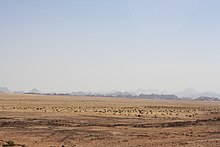Humayma
Arabic: الحميمة | |
| Location | Jordan |
|---|---|
| Region | Aqaba Governorate |
| Coordinates | 29°57′0″N 35°20′49″E / 29.95000°N 35.34694°E |
Humayma (Arabic: الحميمة, romanized: al-Humayma) also spelled Humeima and Humaima, is the modern name of ancient Hawara.[1][2][3] Hawara was a trading post in southern Jordan that was founded by the Nabataean king Aretas III in the early first century BC.[1] It is located 45 km to the south of the Nabataean capital Petra and 55 km to the north of the Red Sea port town of Aqaba.[4]
History
Humeima was occupied from about 90 BC until the Early Islamic period,[5] and has Nabataean, Roman, Byzantine and Islamic remains, including a Roman bath and fort, five Byzantine churches, and a qasr or fortified palace from the Umayyad Period.[1][3]
Nabataean and Roman periods

The settlement was founded by Aretas III as a stop on the trade route from Petra to Gulf of Aqaba.[6] During the Greco-Roman era, it was called "Auara" (Greek: Αὔαρα), derived from "Hawara", which means "white" in Aramaic.[7][a]
Abbasid period
The town was the home of the Abbasid, or Banu Abbas family, around AD 700, who eventually overthrew the Umayyad dynasty and took over the title of caliph, and as such it was the birthplace of the first three Abbasid caliphs: As-Saffah (r. 750–754), Al-Mansur (r. 754–775) and Al-Mahdi (r. 775–785). The family residence of the Abbasids which was a large qasr had a roughly square plan, approximately 61 by 50 m, with a recessed entrance facing east, and a large central court, arguably one of the so-called desert castles, of which very little remains today.[8][9][10][11]
Climate
As rainfall is only 80 mm[12] annually, an extensive water storage and irrigation works lies in the ruins.[2][13]
Notable residents
Chronologically:
- Abd-Allah ibn Muhammad ibn al-Hanafiyyah (died c. 716 in Humayma), an early Muslim jurist and narrator of hadith
- Muhammad ibn Ali ibn Abdallah (c. 680 - c. 744), the progenitor of the Abbasid dynasty, born in Humayma
- Sallamah Umm Abdallah, ancestor of Abbasid dynasty, mother of caliph al-Mansur and grandmother of Abbasid Caliph al-Mahdi.
- Al-Mansur (714–775), the second Abbasid Caliph (r. 754–775), born at Humeima
- As-Saffah (721/722–754), the first Abbasid Caliph (r. 750–754), born at Humeima
- Al-Mahdi (744/45–785), the third Abbasid Caliph (r. 775–785), born at Humeima
- Ja'far ibn Abdallah al-Mansur, an Abbasid prince and father of Zubaidah (766 – 831)
See also
Notes
- ^ Hawara as mentioned by Ptolemy in the Tabula Peutingeriana.
References
- ^ a b c John Peter Oleson. "The history and goals of the Humayma Excavation ProjectT". University of Victoria, British Columbia, Canada. Retrieved 29 July 2019.
- ^ a b Humeima at nabataea.net (copyright 2002)
- ^ a b Ghazi Bisheh , 2018. 2018."Humayma" in Discover Islamic Art, Museum With No Frontiers.
- ^ Oleson, J. P., "Humaima" in: The Oxford Encyclopaedia of Archaeology in the Near East, E. M. Meyers (ed), Oxford, 1997, Vol. 3, pp.121–2.
- ^ Humaima Attraction in Aqaba Humayma Archived 2018-03-06 at the Wayback Machine.
- ^ Ghazi Bisheh , 2018. "Humayma" in Discover Islamic Art, Museum With No Frontiers.
- ^ "Auara, Humayma". Digital Atlas of the Roman Empire.
- ^ "Humeima Desert Castles in Jordan". jordan-travel.com.
- ^ Bisheh, Ghazi (2021). "Humayma". Discover Islamic Art, Museum With No Frontiers (MWNF). Retrieved 8 March 2021.
- ^ Humeima at Nabataea.net, CanBooks, accessed 8 March 2021.
- ^ Humeima Abbas House at Nabataea.net, CanBooks, accessed 8 March 2021.
- ^ "JMD English Site".
- ^ Trekking from Petra to Wadi Rum.
Sources
- Kuhnen, Hans-Peter; Ritter-Burkert, Johanna; Pfahl, Stefan Franz (2018). Wüstengrenze des Imperium Romanum – Die Schicksalsgrenze Roms im Orient von Augustus bis Heraclius (in German). Mainz: Nünnerich-Asmus Verlag & Media GmbH. ISBN 978-3-96176-010-7.

